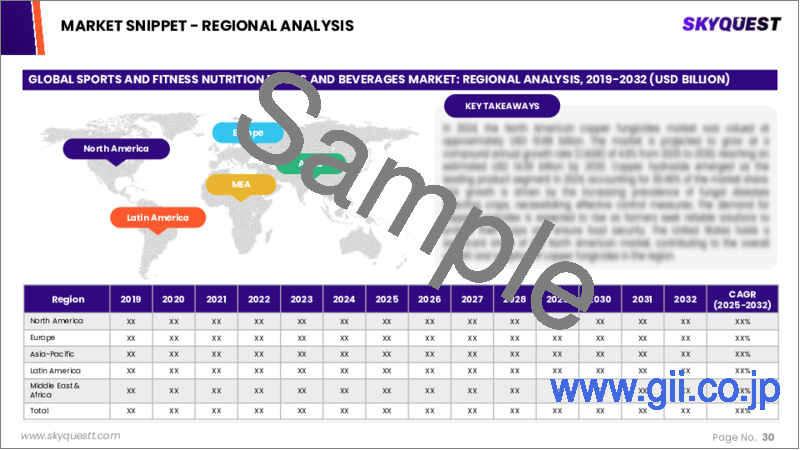|
|
市場調査レポート
商品コード
1673590
スポーツ・フィットネス栄養食品および飲料の市場規模、シェア、成長分析:製品タイプ別、形態別、流通チャネル別、エンドユーザー別、地域別 - 産業予測 2025~2032年Sports and Fitness Nutrition Foods and Beverages Market Size, Share, and Growth Analysis, By Product Type (Sports Supplements, Sports Drinks), By Form (Tablets, Capsules), By Distribution Channel, By End User, By Region - Industry Forecast 2025-2032 |
||||||
|
|||||||
| スポーツ・フィットネス栄養食品および飲料の市場規模、シェア、成長分析:製品タイプ別、形態別、流通チャネル別、エンドユーザー別、地域別 - 産業予測 2025~2032年 |
|
出版日: 2025年03月03日
発行: SkyQuest
ページ情報: 英文 198 Pages
納期: 3~5営業日
|
全表示
- 概要
- 目次
スポーツ・フィットネス栄養食品および飲料の世界市場規模は、2023年に448億米ドルと評価され、予測期間(2025-2032年)のCAGRは7.2%で成長し、2024年の480億3,000万米ドルから2032年には837億6,000万米ドルに成長する見通しです。
スポーツ・フィットネス栄養食品および飲料市場は、栄養バーやエネルギーバーの人気上昇に加え、レディ・トゥ・ドリンクの提供により、大きな成長が見込まれています。タンパク質は重要な成分としてだけでなく、バランスの取れた食生活に欠かせない要素として認識されつつあり、体重管理や免疫サポートに貢献しています。アスリートやフィットネス愛好家がパフォーマンス、持久力、回復力を高める栄養製品を求めていることから、この動向は2023年から2030年にかけて市場の拡大を促進するとみられます。しかし、市場は栄養教育が不十分であるという顕著な課題に直面しており、これが成長の可能性を妨げる可能性があります。業界の進化は、消費者の意識を最大化し、フィットネス栄養における十分な情報に基づいた選択を促進するための教育格差への対処にかかっています。
目次
イントロダクション
- 調査の目的
- 調査範囲
- 定義
調査手法
- 情報調達
- 二次と一次データの方法
- 市場規模予測
- 市場の前提条件と制限
エグゼクティブサマリー
- 世界市場の見通し
- 供給と需要の動向分析
- セグメント別機会分析
市場力学と見通し
- 市場概要
- 市場規模
- 市場力学
- 促進要因と機会
- 抑制要因と課題
- ポーターの分析
主な市場の考察
- 重要成功要因
- 競合の程度
- 主な投資機会
- 市場エコシステム
- 市場の魅力指数(2024年)
- PESTEL分析
- マクロ経済指標
- バリューチェーン分析
- 価格分析
- 規制情勢
- ケーススタディ
- 技術の進歩
スポーツ・フィットネス栄養食品および飲料市場規模:製品タイプ別& CAGR(2025-2032)
- 市場概要
- スポーツサプリメント
- プロテインサプリメント
- ビタミン
- ミネラル
- アミノ酸
- プロバイオティクス
- オメガ3脂肪酸
- 炭水化物
- デトックスサプリメント
- 電解質
- その他
- スポーツドリンク
- スポーツフード
- 食事代替品
- 減量製品
スポーツ・フィットネス栄養食品および飲料市場規模:形態別& CAGR(2025-2032)
- 市場概要
- タブレット
- カプセル
- 粉末
- ソフトジェル
- 液体
- その他
スポーツ・フィットネス栄養食品および飲料市場規模:流通チャネル別& CAGR(2025-2032)
- 市場概要
- レンガとモルタル
- 直接販売
- 薬局
- 健康食品店
- ハイパーマーケット
- スーパーマーケット
- eコマース
スポーツ・フィットネス栄養食品および飲料市場規模:エンドユーザー別& CAGR(2025-2032)
- 市場概要
- 子供
- 大人
- 高齢者
スポーツ・フィットネス栄養食品および飲料市場規模:地域別& CAGR(2025-2032)
- 北米
- 米国
- カナダ
- 欧州
- ドイツ
- スペイン
- フランス
- 英国
- イタリア
- その他欧州地域
- アジア太平洋地域
- 中国
- インド
- 日本
- 韓国
- その他アジア太平洋地域
- ラテンアメリカ
- ブラジル
- その他ラテンアメリカ地域
- 中東・アフリカ
- GCC諸国
- 南アフリカ
- その他中東・アフリカ
競合情報
- 上位5社の比較
- 主要企業の市場ポジショニング(2024年)
- 主な市場企業が採用した戦略
- 最近の市場動向
- 企業の市場シェア分析(2024年)
- 主要企業の企業プロファイル
- 企業の詳細
- 製品ポートフォリオ分析
- 企業のセグメント別シェア分析
- 収益の前年比比較(2022-2024)
主要企業プロファイル
- Abbott Laboratories(USA)
- Ajinomoto Co., Inc.(Japan)
- Amway Corporation(USA)
- Atlantic Multipower Germany GmbH & Co. OHG(Germany)
- Key Developments
- Cytosport, Inc.(USA)
- Glanbia plc(Ireland)
- GNC Holdings, Inc.(USA)
- Hammer Nutrition Ltd.(USA)
- Harbin Pharmaceutical Group Co., Ltd.(China)
- Herbalife Nutrition Ltd.(USA)
- Himalaya Drug Company(India)
- Isostar(Switzerland)
- Kerry Group plc(Ireland)
- MusclePharm Corporation(USA)
- Nestle S.A.(Switzerland)
- NutraClick, LLC(USA)
- Nutrex Research, Inc.(USA)
- Nutrabolt(USA)
結論と提言
Global Sports and Fitness Nutrition Foods and Beverages Market size was valued at USD 44.8 billion in 2023 and is poised to grow from USD 48.03 billion in 2024 to USD 83.76 billion by 2032, growing at a CAGR of 7.2% during the forecast period (2025-2032).
The sports fitness nutrition foods and beverages market is poised for significant growth, driven by the rising popularity of nutrition and energy bars, along with ready-to-drink offerings. Proteins are increasingly recognized not just as a vital ingredient but also as an essential element of a balanced diet, contributing to weight management and immune support. This trend is set to enhance market expansion from 2023 to 2030, as athletes and fitness enthusiasts seek nutritional products to boost performance, endurance, and recovery. However, the market faces a notable challenge: insufficient nutrition education, which may hinder growth potential. The industry's evolution hinges on addressing educational gaps to maximize consumer awareness and promote informed choices in fitness nutrition.
Top-down and bottom-up approaches were used to estimate and validate the size of the Global Sports And Fitness Nutrition Foods And Beverages market and to estimate the size of various other dependent submarkets. The research methodology used to estimate the market size includes the following details: The key players in the market were identified through secondary research, and their market shares in the respective regions were determined through primary and secondary research. This entire procedure includes the study of the annual and financial reports of the top market players and extensive interviews for key insights from industry leaders such as CEOs, VPs, directors, and marketing executives. All percentage shares split, and breakdowns were determined using secondary sources and verified through Primary sources. All possible parameters that affect the markets covered in this research study have been accounted for, viewed in extensive detail, verified through primary research, and analyzed to get the final quantitative and qualitative data.
Global Sports And Fitness Nutrition Foods And Beverages Market Segments Analysis
Global Sports and Fitness Nutrition Foods and Beverages Market is segmented by Product Type, Form, Distribution Channel, End User and region. Based on Product Type, the market is segmented into Sports Supplements, Sports Drinks, Sports Foods, Meal Replacement Products and Weight Loss Product. Based on Form, the market is segmented into Tablets, Capsules, Powder, Softgels, Liquid and Others. Based on Distribution Channel, the market is segmented into Brick & Mortar and E-commerce. Based on End User, the market is segmented into Children, Adults and Geriatric. Based on region, the market is segmented into North America, Europe, Asia Pacific, Latin America and Middle East & Africa.
Driver of the Global Sports And Fitness Nutrition Foods And Beverages Market
The growth of the global sports and fitness nutrition foods and beverages market can be attributed to several key factors. These include the swift urbanization, a rising demographic of non-traditional users, and the overall expansion of the sports nutrition sector. Additionally, the proliferation of fitness centers and health clubs has significantly contributed to the market's ascent during the forecast period. As more individuals engage in fitness activities and seek nutritional support, the demand for specialized food and beverage products designed to enhance athletic performance and promote overall health continues to escalate, driving market growth further.
Restraints in the Global Sports And Fitness Nutrition Foods And Beverages Market
The growth of the global sports and fitness nutrition foods and beverages market may be hindered by several factors, including a lack of practical knowledge in meal planning and limited access to appropriate food options. Frequent travel and demanding schedules can further exacerbate these challenges, making it difficult for consumers to maintain a balanced and nutritious diet tailored to their active lifestyles. This inaccessibility and knowledge gap can impede individuals from fully embracing sports nutrition products, ultimately restraining the market's potential for expansion and diminishing consumer engagement in this sector.
Market Trends of the Global Sports And Fitness Nutrition Foods And Beverages Market
The Global Sports and Fitness Nutrition Foods and Beverages market is experiencing a significant upward trend, driven by a consumer shift towards convenience and the rising popularity of sports beverages as refreshing hydration options. This trend is further bolstered by frequent product innovations featuring natural ingredients that offer sustained energy benefits, appealing to health-conscious individuals. Additionally, as more consumers embrace active lifestyles and prioritize their nutritional intake, the demand for tailored products that support performance and recovery continues to surge. This evolving landscape indicates a robust market trajectory, poised for continued growth as brands adapt to meet diverse consumer needs.
Table of Contents
Introduction
- Objectives of the Study
- Scope of the Report
- Definitions
Research Methodology
- Information Procurement
- Secondary & Primary Data Methods
- Market Size Estimation
- Market Assumptions & Limitations
Executive Summary
- Global Market Outlook
- Supply & Demand Trend Analysis
- Segmental Opportunity Analysis
Market Dynamics & Outlook
- Market Overview
- Market Size
- Market Dynamics
- Drivers & Opportunities
- Restraints & Challenges
- Porters Analysis
- Competitive rivalry
- Threat of substitute
- Bargaining power of buyers
- Threat of new entrants
- Bargaining power of suppliers
Key Market Insights
- Key Success Factors
- Degree of Competition
- Top Investment Pockets
- Market Ecosystem
- Market Attractiveness Index, 2024
- PESTEL Analysis
- Macro-Economic Indicators
- Value Chain Analysis
- Pricing Analysis
- Regulatory Landscape
- Case Studies
- Technological Advancement
Global Sports and Fitness Nutrition Foods and Beverages Market Size by Product Type & CAGR (2025-2032)
- Market Overview
- Sports Supplements
- Protein Supplements
- Vitamins
- Minerals
- Amino Acids
- Probiotics
- Omega -3 Fatty Acids
- Carbohydrates
- Detox Supplements
- Electrolytes
- Others
- Sports Drinks
- Sports Foods
- Meal Replacement Products
- Weight Loss Product
Global Sports and Fitness Nutrition Foods and Beverages Market Size by Form & CAGR (2025-2032)
- Market Overview
- Tablets
- Capsules
- Powder
- Softgels
- Liquid
- Others
Global Sports and Fitness Nutrition Foods and Beverages Market Size by Distribution Channel & CAGR (2025-2032)
- Market Overview
- Brick & Mortar
- Direct Selling
- Chemist/Pharmacies
- Health Food Shops
- Hyper Markets
- Super Markets
- E-commerce
Global Sports and Fitness Nutrition Foods and Beverages Market Size by End User & CAGR (2025-2032)
- Market Overview
- Children
- Adults
- Geriatric
Global Sports and Fitness Nutrition Foods and Beverages Market Size & CAGR (2025-2032)
- North America (Product Type, Form, Distribution Channel, End User)
- US
- Canada
- Europe (Product Type, Form, Distribution Channel, End User)
- Germany
- Spain
- France
- UK
- Italy
- Rest of Europe
- Asia Pacific (Product Type, Form, Distribution Channel, End User)
- China
- India
- Japan
- South Korea
- Rest of Asia-Pacific
- Latin America (Product Type, Form, Distribution Channel, End User)
- Brazil
- Rest of Latin America
- Middle East & Africa (Product Type, Form, Distribution Channel, End User)
- GCC Countries
- South Africa
- Rest of Middle East & Africa
Competitive Intelligence
- Top 5 Player Comparison
- Market Positioning of Key Players, 2024
- Strategies Adopted by Key Market Players
- Recent Developments in the Market
- Company Market Share Analysis, 2024
- Company Profiles of All Key Players
- Company Details
- Product Portfolio Analysis
- Company's Segmental Share Analysis
- Revenue Y-O-Y Comparison (2022-2024)
Key Company Profiles
- Abbott Laboratories (USA)
- Company Overview
- Business Segment Overview
- Financial Updates
- Key Developments
- Ajinomoto Co., Inc. (Japan)
- Company Overview
- Business Segment Overview
- Financial Updates
- Key Developments
- Amway Corporation (USA)
- Company Overview
- Business Segment Overview
- Financial Updates
- Key Developments
- Atlantic Multipower Germany GmbH & Co. OHG (Germany)
- Company Overview
- Business Segment Overview
- Financial Updates
- Key Developments
- Cytosport, Inc. (USA)
- Company Overview
- Business Segment Overview
- Financial Updates
- Key Developments
- Glanbia plc (Ireland)
- Company Overview
- Business Segment Overview
- Financial Updates
- Key Developments
- GNC Holdings, Inc. (USA)
- Company Overview
- Business Segment Overview
- Financial Updates
- Key Developments
- Hammer Nutrition Ltd. (USA)
- Company Overview
- Business Segment Overview
- Financial Updates
- Key Developments
- Harbin Pharmaceutical Group Co., Ltd. (China)
- Company Overview
- Business Segment Overview
- Financial Updates
- Key Developments
- Herbalife Nutrition Ltd. (USA)
- Company Overview
- Business Segment Overview
- Financial Updates
- Key Developments
- Himalaya Drug Company (India)
- Company Overview
- Business Segment Overview
- Financial Updates
- Key Developments
- Isostar (Switzerland)
- Company Overview
- Business Segment Overview
- Financial Updates
- Key Developments
- Kerry Group plc (Ireland)
- Company Overview
- Business Segment Overview
- Financial Updates
- Key Developments
- MusclePharm Corporation (USA)
- Company Overview
- Business Segment Overview
- Financial Updates
- Key Developments
- Nestle S.A. (Switzerland)
- Company Overview
- Business Segment Overview
- Financial Updates
- Key Developments
- NutraClick, LLC (USA)
- Company Overview
- Business Segment Overview
- Financial Updates
- Key Developments
- Nutrex Research, Inc. (USA)
- Company Overview
- Business Segment Overview
- Financial Updates
- Key Developments
- Nutrabolt (USA)
- Company Overview
- Business Segment Overview
- Financial Updates
- Key Developments





